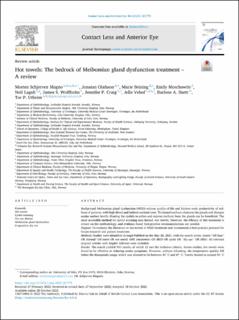| dc.contributor.author | Magnø, Morten Schjerven | |
| dc.contributor.author | Olafsson, Jonatan | |
| dc.contributor.author | Beining, Marie Wangen | |
| dc.contributor.author | Moschowits, Emily | |
| dc.contributor.author | Lagali, Neil Satish | |
| dc.contributor.author | Wolffsohn, James S. | |
| dc.contributor.author | Craig, Jennifer P. | |
| dc.contributor.author | Vehof, Jelle | |
| dc.contributor.author | Dartt, Darlene Ann | |
| dc.contributor.author | Utheim, Tor Paaske | |
| dc.date.accessioned | 2023-04-28T12:55:34Z | |
| dc.date.available | 2023-04-28T12:55:34Z | |
| dc.date.created | 2022-11-11T11:13:31Z | |
| dc.date.issued | 2022 | |
| dc.identifier.citation | Schjerven Magno, M., Olafsson, J., Beining, M., Moschowits, E., Lagali, N., Wolffsohn, J. S., Craig, J. P., Vehof, J., Dartt, D. A. & Utheim, T. P. (2023). Hot towels: The bedrock of Meibomian gland dysfunction treatment – A review. Contact Lens and Anterior Eye, 46(2), Artikkel 101775. | en_US |
| dc.identifier.issn | 1367-0484 | |
| dc.identifier.uri | https://hdl.handle.net/11250/3065611 | |
| dc.description.abstract | Background: Meibomian gland dysfunction (MGD) reduces quality-of-life and hinders work productivity of millions of patients, with high direct and indirect societal costs. Thickened meibum obstructs the glands and disrupts ocular surface health. Heating the eyelids to soften and express meibum from the glands can be beneficial. The most accessible method for eyelid warming uses heated, wet towels. However, the efficacy of this treatment is reliant on the methodology, and evidence-based best-practice recommendations are needed.
Purpose: To evaluate the literature on hot towels in MGD treatment and recommend a best-practice protocol for future research and patient treatment.
Methods: Studies were identified through PubMed on the May 28, 2021, with the search terms: (warm* OR heat* OR thermal* OR towel OR wet towel) AND (meibomian OR MGD OR eyelid OR “dry eye” OR DED). All relevant original articles with English full-text were included.
Results: The search yielded 903 results, of which 22 met the inclusion criteria. Across studies, hot towels were found to be effective at reducing ocular symptoms. However, without reheating, the temperature quickly fell below the therapeutic range, which was deemed to be between 40 °C and 47 °C. Towels heated to around 45 °C and reheated every-two minutes were most effective at increasing eyelid temperature, comparable or better than several commercially available eyelid warming devices. No adverse effects were reported in the studies.
Conclusion: Hot towel treatment effectively warms the eyelids and reduces ocular symptoms, but must be standardized, and towels reheated to achieve maximum benefit. Future research should assess patient satisfaction with different hot towel treatment methods that reheat or replace the towel at least every-two minutes, to establish which methods yield the greatest compliance. Guidelines or clinical recommendations that do not mention the need for regular reheating during hot towel compress treatment should be updated to include this. | en_US |
| dc.language.iso | eng | en_US |
| dc.rights | Navngivelse 4.0 Internasjonal | * |
| dc.rights.uri | http://creativecommons.org/licenses/by/4.0/deed.no | * |
| dc.title | Hot towels: The bedrock of Meibomian gland dysfunction treatment – A review | en_US |
| dc.type | Peer reviewed | en_US |
| dc.type | Journal article | en_US |
| dc.description.version | publishedVersion | en_US |
| dc.rights.holder | © 2022 The Author(s). | en_US |
| dc.source.pagenumber | 1-11 | en_US |
| dc.source.volume | 46 | en_US |
| dc.source.journal | Contact lens & anterior eye | en_US |
| dc.source.issue | 2 | en_US |
| dc.identifier.doi | https://doi.org/10.1016/j.clae.2022.101775 | |
| dc.identifier.cristin | 2072363 | |
| dc.source.articlenumber | 101775 | en_US |
| cristin.ispublished | true | |
| cristin.fulltext | original | |
| cristin.qualitycode | 1 | |

